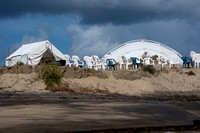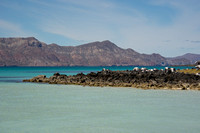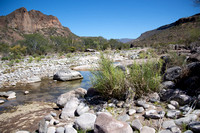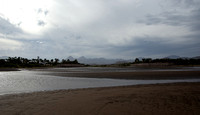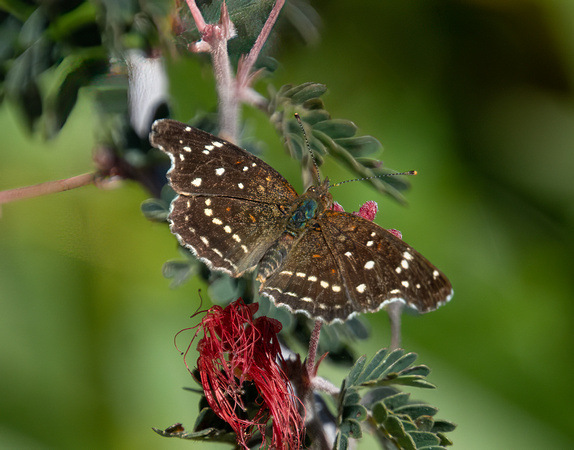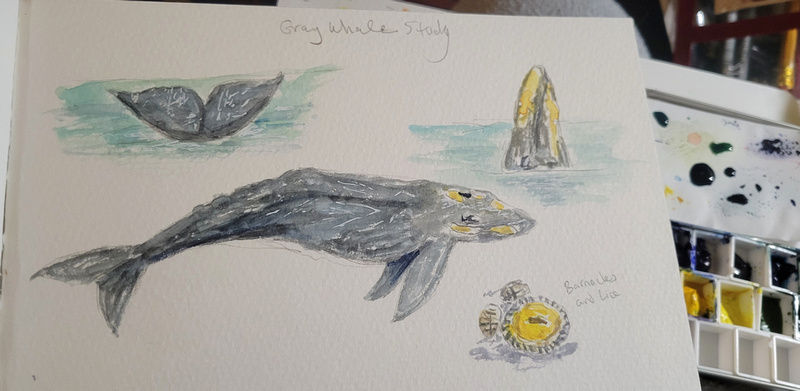Baja Sur - Travels Part 1: Field Arts Bootcamp
I need a vacation from my vacation.
The trip was so jam-packed with habitats, nature, and learning, that I am breaking up the experience into three blogs. This is Part 1 and covers an overview, trip organization and people, and field arts. Part 2 will focus on Magdalena Bay, Gray Whales, and Whale Camp. Part 3 will cover Isla Coronado, The Mountains, and Loreto and the Estuary.
Before any vacation there is a lot of work before, during and after. This one was no different. It started with planning and packing. I wrote a whole separate blog about that last month. https://kimssight.zenfolio.com/blog/2023/1/preparing-and-paring. Then there was the eight days of vacation which included travel time, much time unpacking and repacking, and packing the day pack as I moved from activity to activity. When I got home, I had to unpack, do laundry, catch up on email and bills, etc. Oh yes, and a long hot shower. Then add to that the downloading, identifying, labeling, and posting of photos to iNaturalist, eBird, and my website. I capped it all off with my blog. It is a lot of work, but that is just the price I pay as a naturalist for learning and moments of pure joy.
This trip was an immersive Baja Field Arts Bootcamp. Could there be a better fit for me? Baja, whales, Sea of Cortez, naturalist skills, field arts! It was three days/two nights at whale camp on the Pacific side in Bahía Magdalena watching Gray Whales and a tour of the mangroves. There was a day of optional snorkeling and beach combing at Isla Coronado in the Sea of Cortez with rocky shores and sandy beaches. Next was a day in the mountains that separate the two sides. Finally, there was a day at the beach exploring town and the mudflats of the estuary in Loreto. Instead of the quiet contemplative experience of journaling and improving my journaling practice as I expected, we had an activity packed adventure.
|
Whale Camp, Magdalena Bay |
Isla Coronado, Sea of Cortez |
In the Mountains |
Estuary in Loreto |
The trip was organized by Roseann Hanson, with her husband Jonathan. They are an extraordinary couple of adventurers, naturalists, and expedition leaders. Their website is https://www.exploringoverland.com/. They really looked out for us in terms of safety. That is something I particularly appreciate as I call myself an adventurous wimp. They carried a satellite communications device for our remote travels, safety gear, and supplies. Fortunately, it was never put to the test. They made constant head counts of the group, checked that everyone was accounted for before leaving the hotel and at night. They reminded us of sunblock, hand sanitizer, and hydration. They helped track lost luggage (not mine), late arrivals (one couple), coordinated with hotel services (hot water), restaurants, taxis, vans, sick people (two couples who needed the Imodium), and all tips. This kind of safety prep did not go unnoticed by me. It is so important to travel with a reputable organization. They worked with a local operator, ROW Adventures: https://www.rowadventures.com/. ROW did an excellent job also. They hired local biologists as leaders. The local guides had the opportunity to be in the field and give nature talks, but they also had to deal with the logistics from menu orders, camp setup, carrying toilet paper and water, and emptying the pee buckets. There was also a cook at camp. Mario was one of the local guides. He let us know he had two masters’ degrees. He gave the talks at Whale Camp, and what he called the “blah, blah, blah”. Rafa did more of the ‘other’ activities. Diana was new and in training. All three were a joy. Finding satisfying work as a biologist is always a challenge. The season with the whales is from February to mid-March and then the guides are on to other assignments and/or back to school.
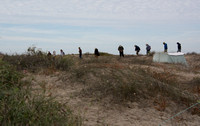 on a hikeon a hike
on a hikeon a hike
Baja California Sur, MX
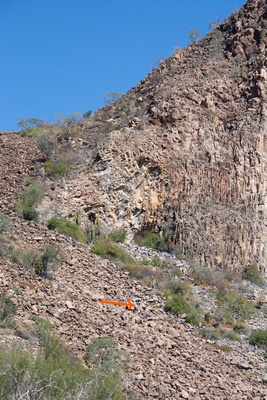 The group climbing to the pictographsThe group climbing to the pictographs
The group climbing to the pictographsThe group climbing to the pictographs
Between Rancho Santo Domingo and the Pictographs, 02/16/2023 In addition to our expedition leaders, there were sixteen of us who all came from different places, literally and figuratively. I could tell that others have also had experience guiding groups, not just from the fact that they told us they were teachers, wilderness guides, and park docents, but also from the way they helped act as group translators, people herders, and crossing guards. I was very impressed with their knowledge, skills, friendliness, and adventurous spirit, not to mention their athleticism. While some were under retirement age, the majority were above. While I was babying my recently injured hip, trying not to reinjure it walking in sand and on uneven pavement (fortunately it didn’t give me much grief), others were scampering over sand dunes and taking brisk walks into town. I skipped the arduous rock climb to the pictographs. The guide said it was easy, but Roseann warned us it was not. Several of us opted for a nature walk instead.
In addition to our expedition leaders, there were sixteen of us who all came from different places, literally and figuratively. I could tell that others have also had experience guiding groups, not just from the fact that they told us they were teachers, wilderness guides, and park docents, but also from the way they helped act as group translators, people herders, and crossing guards. I was very impressed with their knowledge, skills, friendliness, and adventurous spirit, not to mention their athleticism. While some were under retirement age, the majority were above. While I was babying my recently injured hip, trying not to reinjure it walking in sand and on uneven pavement (fortunately it didn’t give me much grief), others were scampering over sand dunes and taking brisk walks into town. I skipped the arduous rock climb to the pictographs. The guide said it was easy, but Roseann warned us it was not. Several of us opted for a nature walk instead.
Field Arts
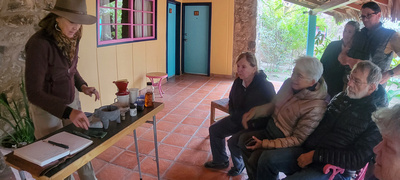
 We had two whale talks by Mario, one each on the two nights in camp. They were excellent presentations, and I learned a few new things. Jonathan showed people how to use the binoculars. They lent us Swarovski Optics binoculars for the trip. Roseann has a wealth of knowledge, and I could tell that she wanted to share more than we had time for. She gave a demonstration and lesson on color mixing with watercolors. That was good for those who are newer to art. She showed us how she does her page layouts. In the field she showed how to measure tracks and talked about how to make plaster casts. On the last night, Roseann showed us how to make paint from natural pigments and binders. She used soil she collected while we were in the field.
We had two whale talks by Mario, one each on the two nights in camp. They were excellent presentations, and I learned a few new things. Jonathan showed people how to use the binoculars. They lent us Swarovski Optics binoculars for the trip. Roseann has a wealth of knowledge, and I could tell that she wanted to share more than we had time for. She gave a demonstration and lesson on color mixing with watercolors. That was good for those who are newer to art. She showed us how she does her page layouts. In the field she showed how to measure tracks and talked about how to make plaster casts. On the last night, Roseann showed us how to make paint from natural pigments and binders. She used soil she collected while we were in the field.
With all the activities, travel, talks, and socializing, we didn’t have much opportunity for our own journaling practice. However, I did have the opportunity to see other people’s perspectives on journaling.
Naturalists used to journal because cameras, cell phones, and other techniques were not available. They noted species, drew pictures, made field notes, and captured metadata such as location, weather, and time. These were done in the field as they went, or in their field camps. Modern nature journaling seems to be more of an artform. It includes quiet observation, contemplation, art, poetry, and a host of individual preferences. I asked a few people how they use their journal practice, and also observed what others were doing.

 On the last day we gave presentations to children and showed our journals (I did mine in Spanish, dredging up forgotten vocabulary and grammar). This was the best opportunity to learn from others.
On the last day we gave presentations to children and showed our journals (I did mine in Spanish, dredging up forgotten vocabulary and grammar). This was the best opportunity to learn from others.
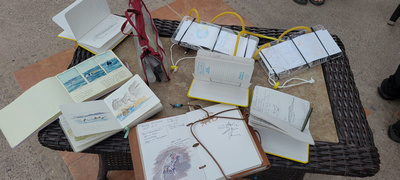 Group share
Group share Some people took time in the evening to work on their journals from photos on their cell phones or from memory. Some did little to no journaling on the trip, but some people thought they would work from photos when they got home. Some did more writing, some did more art, some made quick spontaneous sketches and notes, some were more scientific, some artistic, some whimsical. It was a delight to see all the creativity, and I got an understanding of journaling in a new way.
Some people took time in the evening to work on their journals from photos on their cell phones or from memory. Some did little to no journaling on the trip, but some people thought they would work from photos when they got home. Some did more writing, some did more art, some made quick spontaneous sketches and notes, some were more scientific, some artistic, some whimsical. It was a delight to see all the creativity, and I got an understanding of journaling in a new way.
Seeing others work and how they use it gave me more insight into my own practice. I love beautiful journals such as Roseann’s, with scientific notes and beautiful pictures. She spends a lot of time in the field without electronics. She meticulously indexes her pages and captures metadata. She writes as much as she sketches, often in the evening or completing a page over several days. As a result, her journals are scientific and beautiful.
Without time in the schedule, I had to force myself to carve out some time to do some quick field sketches. Instead, I leaned into my naturalist skills. I use electronic means to aid in capturing my observations. I recorded my birds in the field in eBird. While I did not list every bird I saw, I wanted to capture at least one of every species I saw. I photographed my observations of some of the birds and insects for a record and for later identification.
 So many water crossingsSo many water crossings
So many water crossingsSo many water crossings
The drive from San Javier to Rancho Santo Domingo, 02/16/2023 It is hard to shoot from a moving car or boat, and I prefer to take my time for good shots, but for documentation purposes you take what you can get. I did get a few good quality shots. The camera captured metadata such as date and time. One of my cameras captured GPS. I captured field notes electronically and entered them on my phone as incomplete thoughts. I often wake up in the middle of the night or very early in the morning to capture my thoughts before the noise of the day begins. At home I go into the other room and write on the computer. In the hotel room or in the tent, I didn't want to disturb my roommate. It was too windy and cold to go outside, so I sometimes sat in the hotel bathroom at 3am to write my notes. I guess this is my form of journaling, but I won’t have a pretty book at the end of the day. Instead, I will have shareable and searchable observations. It will be shared in iNaturalist and my own website, and can be used in this blog.
It is hard to shoot from a moving car or boat, and I prefer to take my time for good shots, but for documentation purposes you take what you can get. I did get a few good quality shots. The camera captured metadata such as date and time. One of my cameras captured GPS. I captured field notes electronically and entered them on my phone as incomplete thoughts. I often wake up in the middle of the night or very early in the morning to capture my thoughts before the noise of the day begins. At home I go into the other room and write on the computer. In the hotel room or in the tent, I didn't want to disturb my roommate. It was too windy and cold to go outside, so I sometimes sat in the hotel bathroom at 3am to write my notes. I guess this is my form of journaling, but I won’t have a pretty book at the end of the day. Instead, I will have shareable and searchable observations. It will be shared in iNaturalist and my own website, and can be used in this blog.
I have gained a deeper understanding of field arts, what it is for others, and what journaling will be for me. I would like to continue my practice of field sketching for quiet contemplation, pleasure, and a casual pastime, but no longer have expectations of making a robust field journal as a naturalist. I am a digital person first.
Magic Moments
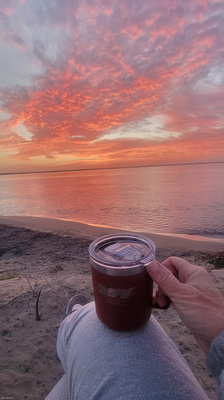 The Way to Start Every DayThe Way to Start Every Day
The Way to Start Every DayThe Way to Start Every Day
Magdelena Bay, BCS, 02/12/2023 I feel most like Kim when I am in the field with a small group of similarly interested people. Some of my favorite moments came when I decided to forego the main group activities and spend time alone or with a smaller sub-group of people. It gave me time to observe and think. I loved taking a walk up the hill and down the beach while the group did a trek over the dunes. I loved sitting on the boat and watching the Brown and Blue-footed Boobies, and sketching while others were out journaling in the cold water. I loved walking on the mudflats and exploring with just one or two other people. I loved the fabulous sunrises and sunsets, noting the rapidly changing colors.
I feel most like Kim when I am in the field with a small group of similarly interested people. Some of my favorite moments came when I decided to forego the main group activities and spend time alone or with a smaller sub-group of people. It gave me time to observe and think. I loved taking a walk up the hill and down the beach while the group did a trek over the dunes. I loved sitting on the boat and watching the Brown and Blue-footed Boobies, and sketching while others were out journaling in the cold water. I loved walking on the mudflats and exploring with just one or two other people. I loved the fabulous sunrises and sunsets, noting the rapidly changing colors.
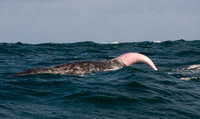 Pink FloydPink Floyd
Pink FloydPink Floyd
Magdelena Bay, BCS, 02/12/2023 We all shared the experience of the “Pink Floyd”, a rare thing to see. For those who don’t know to what I am referring, think about an excited male Gray Whale when he sees his lady love. I felt a strong connection and awe when the Humpback Whale came to each boat, out of what seemed to be curiosity.
We all shared the experience of the “Pink Floyd”, a rare thing to see. For those who don’t know to what I am referring, think about an excited male Gray Whale when he sees his lady love. I felt a strong connection and awe when the Humpback Whale came to each boat, out of what seemed to be curiosity.
I found a crab that looked like a rock in a tidepool and a lizard in a slit in a rock.
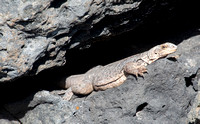 Monserrat Chuckwalla - Sauromalus sleviniMonserrat Chuckwalla - Sauromalus slevini
Monserrat Chuckwalla - Sauromalus sleviniMonserrat Chuckwalla - Sauromalus slevini
Isla Coronado, Baja California Sur, MX, 02/15/2023 I called others over to see. These were my magic moments of observation and discovery.
I called others over to see. These were my magic moments of observation and discovery.
I concentrated on learning the finer differences in plovers in order to find my first Wilson’s Plover on the mudflats. I also enjoyed the surprise of finding a Semipalmated Plover amongst my plover photos only after I got home.
All these beautiful experiences and I barely scratched the surface. I know I will have to go back.
See my other blog posts for more "blah, blah, blah" and photos of each area we explored.
The Highlight Reel
Click here to see the highlights at your own pace. https://kimssight.zenfolio.com/baja_2023_highlights
Journal Pages
Click here to see the highlights at your own pace. https://https://kimssight.zenfolio.com/baja_2023_journal_pages
Next Post: Part 2 will focus on Magdalena Bay, Gray Whales, and Whale Camp. Part 3 will cover Isla Coronado, The Mountains, and Loreto and the Estuary.
Click here to see ALL my photos: https://kimssight.zenfolio.com/baja_feb_2023
Follow me on Facebook: https://www.facebook.com/KimMooreNaturalist/
